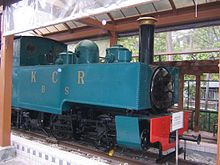Narrow-gauge railways in Asia
China
Some of
Hong Kong

In
India

India's oldest narrow gauge railway station opened in 1863 by Maharaja Khanderao Gaekwad. Dabhoi railway station also known as Gaekwads Railway Station or Baroda State Railway features the oldest narrow gauge line (Dabhoi to Karjan or Miyagam) in the world build in 1950s.
India has five narrow-gauge railways: the metre-gauge Nilgiri Mountain Railway, the 2 ft 6 in (762 mm) Kalka–Shimla Railway and Kangra Valley Railway and the 2 ft (610 mm) Darjeeling Himalayan and Matheran Hill Railways.[1] These Mountain railways of India are UNESCO World Heritage Sites, and avoided conversion to broad gauge under Project Unigauge.
Indonesia
Indonesia had a number of narrow-gauge railways including KRL and supporting industry, primarily sugarcane plantations in Java. Sugarcane production has been declining, and the railways are now largely closed or used for tourism. Most of the country's active railways use the 3 ft 6 in (1,067 mm) gauge.
Japan

Except for the high-speed
, use standard gauge.Tokyo's Keio Corporation network and the Toei Shinjuku subway line, which have through service, use an unusual 1,372 mm (4 ft 6 in) gauge. This gauge is also used on the Tokyo and Hakodate tramways.
Japan adopted 762 mm (2 ft 6 in) as a standard narrow gauge for small, forestry and industrial lines. Most of these narrow-gauge lines were abandoned, and only four remain in operation: the
Malaysia

In
Philippines
Except for the 1,435 mm (4 ft 8+1⁄2 in)
A number of industrial narrow-gauge steam railways are operated by the sugarcane industry, concentrated on the islands of
Abandoned lines remain on the islands of Cebu (abandoned in the 1950s or 1960s), Mindanao and Panay (closed in the 1990s). Panay Railways operated a 3 ft 6 in (1,067 mm) rail line from Roxas City and Iloilo City until the mid-1980s.
Taiwan

A 2 ft 6 in (762 mm), narrow-gauge Alishan Forest Railway stretches 72 kilometres (45 mi) and connects Chiayi to the mountain resort of Alishan. The line is primarily a tourist attraction. On 7 September 2006, the Taiwanese government announced a plan to update to standard gauge.[2]
Thailand
The
